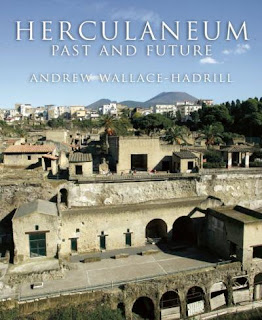Books and Exhibitions: Vesuvius Strikes Again
Volume 64 Number 3, May/June 2011
By Jarrett A. Lobell
In late August A.D. 79, Mount Vesuvius erupted with deadly force. Ash, stone, and scorching hot dust rained down on the southern Italian cities of Pompeii and Herculaneum, completely entombing the cities and their residents, and providing archaeologists with an unparalleled window into everyday life in the first century A.D. Despite a steady stream of publications and documentaries about these sites, Andrew Wallace-Hadrill's book Herculaneum Past and Future(Frances Lincoln Limited, $60) and Pompeii the Exhibit: Life and Death in the Shadow of Vesuvius at Discovery Times Square in New York City (through September 5), prove there is still room for more.
After 10 years as director of the Herculaneum Conservation Project, there is no archaeologist better suited to raise this city from its relative obscurity than Wallace-Hadrill. His book is filled with hundreds of new and archival photographs, panoramic views, and an invaluable foldout map of the site. The book is arranged in highly readable chapters that focus not only on the history of excavations, ancient city planning, and Herculaneum's vibrant fresco paintings and mosaics, but also succeed in populating those spaces. Wherever possible, Wallace-Hadrill tells the individual stories of slaves, citizens, and the elite, using the enormous wealth of archaeological evidence Herculaneum provides—residents' names, their houses, their furniture and food, and even their skeletons. While its visual appeal may lead readers to believe Herculaneum Past and Future is merely a coffee-table book, the research Wallace-Hadrill presents is comprehensive and of the highest quality. The author has filled a gap in the public's knowledge of Herculaneum—an even better-preserved city than its neighbor, Pompeii, only four miles away.
Among the spectacular artifacts at a new exhibit telling the story of Pompeii is a rarely-displayed plaster cast of a pig that died in the eruption of Mount Vesuvius in A.D. 79.
(Running Subway, William Starling)
People are also the focus of Pompeii the Exhibit: Life and Death in the Shadow of Vesuvius. Unlike most exhibits on Pompeii, there is a refreshing lack of sensationalism about the terrifying experience of the eruption. Visitors are made to feel as if they have entered an ancient Roman home. The exposition space's walls are covered in stunning frescoes and mosaic—most of which come from the House of the Golden Bracelet, one of Pompeii's finest properties. This offers an extremely rare chance to see artifacts of this quality outside of Italy. Inside a large room representing a marketplace, cases are filled with artifacts (some real and some excellent replicas) of everyday life, including kitchen utensils, lamps, and even food preserved by the eruption. The full range of ancient Pompeian life, including religion, politics, and even erotica (which is decorously presented in a space resembling a bedroom in one of Pompeii's brothels), is on display.
What will surely be one of the exhibit's biggest attractions are the 20 plaster casts of Vesuvius' victims, some of which were made in the 19th century, although three were created especially for the exhibit. The casts, made from voids left in the hardened ash, preserve a person or animal at the moment of their death, and remind the visitor that the same volcano that preserved the city also killed thousands. For those new to the archaeology of Pompeii and Herculaneum, both the exhibit and the book provide an exciting opportunity to connect with people who lived almost 2,000 years ago.

No comments:
Post a Comment